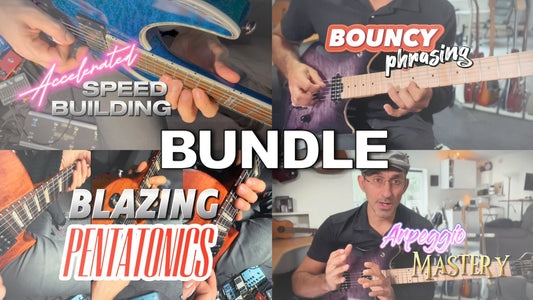Warming Up Rusty Summer Chops
Share
Warming Up Rusty Summer Guitar Chops: A Journey Back to Form
As summer winds down, many of us find ourselves returning to hobbies and passions that may have been set aside for a while. For musicians, especially guitarists, this can mean grappling with the inevitable rust that settles in after weeks or even months of inactivity. In this blog post, I’ll take you through a personal practice session aimed at shaking off that rust and regaining some much-needed chops on the guitar.
The Struggle is Real: Picking Up the Guitar After a Break
After a week of not touching the guitar, and an even longer period of sporadic playing due to summer holidays, my chops are in bad shape. I’m sure many guitarists can relate to the feeling of picking up the guitar after a break and finding that everything feels... off. The first thing I did was simply play, not with any specific warm-up exercises in mind, but just to see what my fingers would do. Surprisingly, this often leads to new ideas or unexpected riffs that wouldn’t have emerged during a more disciplined practice routine.
Embrace the Rust: The Benefits of a Fresh Start
One of the surprising benefits of coming back to the guitar after a break is that you might stumble upon something new. Your brain has been processing the music you’ve practiced and played, and when you pick up the guitar again, it might piece together these fragments into something novel. So, while the rust can be frustrating, it’s also an opportunity. Be aware of your first moments back with the guitar – they can be surprisingly inspirational.
Easing Into the Groove: Legato and Creativity
As I continued playing, I noticed my hands struggling to sync up. This is normal after a break, but instead of pushing through with fast, shredding exercises, I decided to focus on something more manageable – legato playing. This felt fresher and more in tune with where my chops were at that moment. It’s interesting how, when you’re rusty, you’re less likely to fall into your usual cliches and more open to trying out different approaches.
Avoid the Trap: Don’t Push Yourself Too Hard
A word of caution: if you haven’t been playing for a while, don’t push yourself too hard right out of the gate. It’s easy to fall into the trap of trying to play at the speed and complexity you’re used to, but this can lead to frustration or even injury. This session should be about warming up and exploring, not about proving something to yourself. Cherish the slow moments – they’re golden opportunities for growth.
Creative Chromaticism: A Different Kind of Exercise
One approach I took during this session was to mix creativity with traditional exercises. Instead of boring myself with repetitive chromatic scales, I improvised within that framework, allowing for mistakes and surprises. This keeps the practice session engaging and less predictable, which is essential when trying to shake off rust. Even if you’re not an advanced player, you can apply this mindset to your practice.
Posture Matters: Avoiding Bad Habits
It’s easy to slip into bad habits when you’re rusty, and posture is one of those areas where many guitarists falter. I found myself slipping into a less-than-ideal playing position, which can lead to strain or even injury over time. It’s crucial to maintain good posture, especially when you’re trying to rebuild your chops.
Right Hand Focus: Synchronizing and Breaking Patterns
As I started to feel the strain in my left hand, I shifted my focus to the right hand. Synchronizing both hands is challenging, especially when you’re trying to break out of predictable patterns. By picking every note instead of relying on legato or hammer-ons, I forced myself to engage more fully with the rhythm and timing of my playing.
Slow and Steady: The Value of Patience
As tempting as it is to speed up, maintaining a slow tempo is vital when rebuilding your chops. Practicing slowly allows you to be more creative, catch mistakes, and build a solid foundation for more complex playing. It’s at these slower tempos that the most significant improvements can happen – even if it feels less exciting in the moment.
Final Thoughts: Enjoy the Process
Returning to the guitar after a break can be frustrating, but it’s also an opportunity to rediscover your instrument and your creativity. Take your time, enjoy the slow tempos, and don’t be afraid to explore new ideas. Remember, the goal isn’t just to get back to where you were but to find new pathways in your playing. Happy practicing!
Kris



